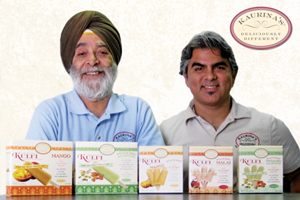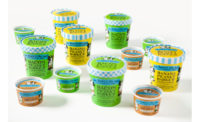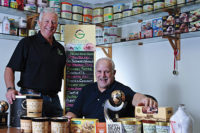
|
|
Kaurina’s won a grand championship award in the 2012 Wisconsin Dairy Product Association’s contest. Hari Singh (left) is president and CEO of Kaurina’s, Aman Singh is executive vice president. |
Kulfi is a frozen dessert originating from India that’s similar to ice cream in appearance and taste, but is typically denser and creamier. It’s a popular dessert street-food found throughout countries such as India, Pakistan, Bangladesh, Nepal, Burma and in the Middle East.
Dallas-based Kaurina’s is poised to do something no other company has done — bring kulfi into the United States mainstream commercial market and make it a recognized frozen dessert alternative.
Kaurina’s has been making a name for itself in niche Texas ethnic markets (predominantly Indian and Pakistani) with its kulfi bars, branded as “what ice cream should be.” The bars are made from pure cooked milk, cane sugar and minimal other natural ingredient flavors.
The company, started by Hari Singh in 2000, is a family-owned and operated business which began in his home kitchen. Singh has a retail background and 30 years experience running businesses. He started Kaurina’s from the ground up by taking his wife’s kulfi product on the road and finding store accounts who would sell it.
Aman Singh, executive vice president of Kaurina’s (and Hari’s son), calls this your “typical family business starting story.”
“My mom used to make this product at home as a dinner dessert,” said Singh. “A lot of folks who have emigrated from India to the United States [brought] a lot of their cuisine with them, and all of those traditions and heritage. Kulfi was something that people enjoyed off the street, at home and in restaurants throughout the country. And it was something that wasn’t available here at the time, so my mom [made] her own version of it that people really took to.”
The kulfi bars are all-natural, gluten-free, have no preservatives, no high-fructose corn syrup and are made with no eggs. Singh points out that the bars aren’t categorically ice cream, “It’s not whipped, it doesn’t go through a batch freezer, it doesn’t have any gums or stabilizers of any kind,” he says. “Kulfi is its own category and that’s what we’re trying to introduce into the market.”
The bars come in nine flavors: pistachio almond, mango, malai (a cardamom cream flavor), vanilla, strawberry, chocolate, coconut, kheer (a rice pudding flavor) and chikoo (a pear and cinnamon flavor, that’s made with the Spanish fruit sapote or sapodilla). The bars are available in a 3-ounce single pack, a four pack of 3-ounce bars, a six-count snack pack of 1.6-ounce bars and four pack of 3-ounce stickless bars (available in pistachio almond, mango and malai only.)
According to Kaurina’s, its kulfi bars are lower in calories, sugar and fat than similar ice cream products. For example, the 1.6-ounce snack size bars are 88 calories, 4 grams of fat and 7 grams of sugar.
The kulfi bars are currently available in niche ethnic grocers in Texas and more mainstream Texas supermarkets like H.E.B. and Fiesta. They are sold online at Artizone.com. The bars can also be found in select niche Indian markets in California, Illinois, New York, Georgia and Oklahoma.
Kaurina’s manufactures the kulfi bars and ice cream (a kulfi and ice cream blend) out of its 5,000-square-foot plant. The plant has the capacity to manufacture 3,000 to 5,000 kulfi bars a day. The company buys its milk wholesale in bulk from Texas farmers through Borden’s Dairies, with certification that it’s hormone/antibiotic free and rBST-free. They receive about three shipments of 120 gallons a week. The natural ingredients are cane sugar, vanilla from Mexico and Dutch cocoa. The mango pulp is imported from India and is the highest quality mango pulp available on the market according to Aman Singh.
Both the kulfi and ice cream kulfi blend are manufactured in the same plant. The bars are made by slow-cooking the milk for a day, then other ingredients are added and the mixture is poured into molds. The bars are then placed in a custom-made tank to freeze. Singh said it’s about a two-day process to make a batch. The bars are then packaged and sold wholesale to retail stores. The ice cream is made in a batch freezer.
The ice cream is currently sold mainly to local Indian and Pakistani markets and is available in half-gallons, quarts, cups and pints and then 2-gallon bulk sizes for foodservice and its catering business. Some of the cross-over flavors from the kulfi bars to the ice cream are: pistachio almond, mango, malai, vanilla, chocolate and strawberry. For now, Singh said they have no plans to bring the ice cream blend into the mainstream. The focus is on marketing the kulfi bars.
Singh said much of the company’s growth and success can be attributed to word-of-mouth and targeting ethnic markets in Texas. They’ve also advertised on local Texas radio. Since 2005 the company has seen a 15% to 20% steady increase in sales, according to Singh.
The company has also put an emphasis on social media with the help of RMD Advertising, Columbus, Ohio. Kaurina’s Facebook page and Twitter feed are prominent on the homepage of the company’s website. Singh said despite its limited marketing budget, the company hopes to drive brand awareness through grass-roots campaigns and use of Facebook and Twitter.
On the horizon for the company is more emphasis on educating the marketplace about what kulfi is and what it has to offer.
“We’re offering something wholly unique to the market,” said Singh. “We’re letting people recognize that kulfi is not just [a] kids treat, it’s not just [a] street food, it’s much more than that. There’s a culture tied to it, there’s a history tied to it.”
Beyond the history of it, the ingredients speak for itself said Singh.
The product’s 10% butterfat contributes to the lower calorie and fat content, and no overrun allows for the richness.
“You have all of the indulgence, but none of the guilt,” said Singh. This is the message he hopes resonates with the mainstream market.


